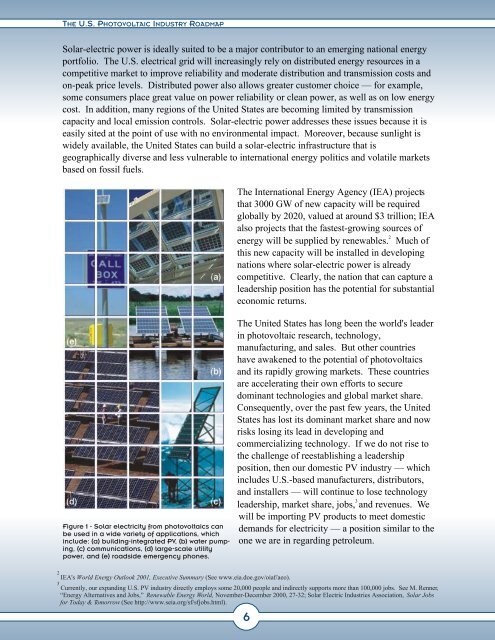Solar Electric Power -- The U.S. Photovoltaic Industry ... - Ecotopia
Solar Electric Power -- The U.S. Photovoltaic Industry ... - Ecotopia
Solar Electric Power -- The U.S. Photovoltaic Industry ... - Ecotopia
Create successful ePaper yourself
Turn your PDF publications into a flip-book with our unique Google optimized e-Paper software.
THE U.S. PHOTOVOLTAIC INDUSTRY ROADMAP<br />
<strong>Solar</strong>-electric power is ideally suited to be a major contributor to an emerging national energy<br />
portfolio. <strong>The</strong> U.S. electrical grid will increasingly rely on distributed energy resources in a<br />
competitive market to improve reliability and moderate distribution and transmission costs and<br />
on-peak price levels. Distributed power also allows greater customer choice — for example,<br />
some consumers place great value on power reliability or clean power, as well as on low energy<br />
cost. In addition, many regions of the United States are becoming limited by transmission<br />
capacity and local emission controls. <strong>Solar</strong>-electric power addresses these issues because it is<br />
easily sited at the point of use with no environmental impact. Moreover, because sunlight is<br />
widely available, the United States can build a solar-electric infrastructure that is<br />
geographically diverse and less vulnerable to international energy politics and volatile markets<br />
based on fossil fuels.<br />
Figure 1 - <strong>Solar</strong> electricity from photovoltaics can<br />
be used in a wide variety of applications, which<br />
include: (a) building-integrated PV, (b) water pump-<br />
ing, (c) communications, (d) large-scale utility<br />
power, and (e) roadside emergency phones.<br />
<strong>The</strong> International Energy Agency (IEA) projects<br />
that 3000 GW of new capacity will be required<br />
globally by 2020, valued at around $3 trillion; IEA<br />
also projects that the fastest-growing sources of<br />
2<br />
energy will be supplied by renewables. Much of<br />
this new capacity will be installed in developing<br />
nations where solar-electric power is already<br />
competitive. Clearly, the nation that can capture a<br />
leadership position has the potential for substantial<br />
economic returns.<br />
<strong>The</strong> United States has long been the world's leader<br />
in photovoltaic research, technology,<br />
manufacturing, and sales. But other countries<br />
have awakened to the potential of photovoltaics<br />
and its rapidly growing markets. <strong>The</strong>se countries<br />
are accelerating their own efforts to secure<br />
dominant technologies and global market share.<br />
Consequently, over the past few years, the United<br />
States has lost its dominant market share and now<br />
risks losing its lead in developing and<br />
commercializing technology. If we do not rise to<br />
the challenge of reestablishing a leadership<br />
position, then our domestic PV industry — which<br />
includes U.S.-based manufacturers, distributors,<br />
and installers — will continue to lose technology<br />
3<br />
leadership, market share, jobs, and revenues. We<br />
will be importing PV products to meet domestic<br />
demands for electricity — a position similar to the<br />
one we are in regarding petroleum.<br />
2<br />
IEA's World Energy Outlook 2001, Executive Summary (See www.eia.doe.gov/oiaf/aeo).<br />
3 Currently, our expanding U.S. PV industry directly employs some 20,000 people and indirectly supports more than 100,000 jobs. See M. Renner,<br />
“Energy Alternatives and Jobs,” Renewable Energy World, November-December 2000, 27-32; <strong>Solar</strong> <strong>Electric</strong> Industries Association, <strong>Solar</strong> Jobs<br />
for Today & Tomorrow (See http://www.seia.org/sf/sfjobs.html).<br />
6


